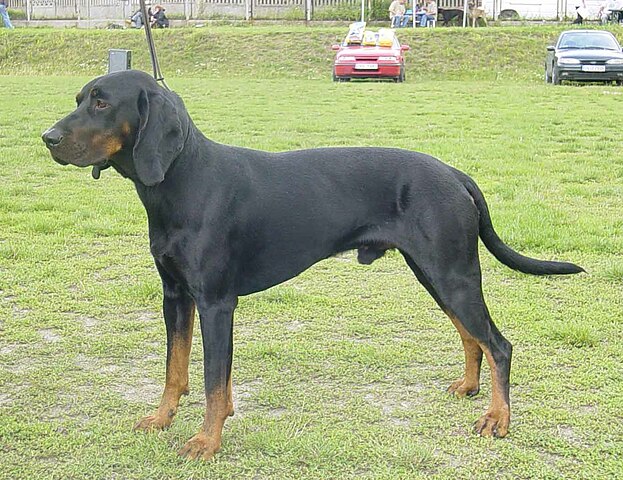The Polish Hunting Dog is an ancient scenthound mainly used for hunting deer and wild boar, and is also used for tracking purposes. Like his cousin the Polish Hound, his ancestors are said to go back to the 13th century. This is a rare breed that is not recognized in the United States although is recognized by the FCI overseas. In terms of hunting abilities and temperament – unlike some scenthounds which were bred to face off against (sometimes very tough) prey, this breed is less likely to jump into a fight that he may lose. He’s generally more of a good-natured and noble fellow than he is a scrappy fighter.
The Hunting Dog isn’t overly stubborn in the way that many scenthounds can be, but can still get caught up and distracted if he sniffs something interesting. Every backyard excursion is likely to include a large amount of time sniffing and investigating the grounds for signs of wildlife. This means that he is amiable and ready to listen in the home when there aren’t distractions to deal with, but that will likely go out the window once he goes outside! With a high prey drive, households with small pets will want to keep those pets safely away from this hunter, and those with cats may want to consider a different breed altogether. On the plus side, the Hunting Dog tends to get along great with other dogs (and also children for that matter). With families, he is not usually recommended for those with very small kids or children who don’t know how to be gentle – he is far too sensitive for harsh handling and may react badly.
The Hunting Dog is intelligent and requires an outlet for his mind. In other words, he needs a job to do! Luckily, he can be quite successful when trained in dog sports including agility, obedience and canine freestyle. An owner must always keep in mind his high exercise requirement when it comes to training, however. If he has spent too much time cooped up in the house he’s going to be harder to train than if that excitable energy has had a proper outlet to be expelled. With enough exercise to get him into the right frame of mind, he can be pleasant and easy to train. It bears repeating again that this breed is sensitive and doesn’t do well when training is overly harsh! Loyal and eager to please, he enjoys learning when it comes from a trusted owner.
Polish Hunting Dogs are quite loving and affectionate towards their owners but may be aloof and suspicious of strangers at first. Once they get to know a new person, however, they become friendly and are always level-headed. They will befriend neighbors as well, and may either bewitch them with their beautiful voices (which can be heard loud and far) or annoy them, depending on the proximity of the neighbor’s property! This unique voice was bred into them in order to signal the hunter as to their whereabouts and hunting status.
Hunting Dogs need owners that are active and able to exercise their hounds daily. They require daily jogs that span at least a couple miles for each excursion, and/or have at least 90 minutes a day being exercised A home with a big backyard isn’t enough! The gold standard of exercise would include regular hunting trips combined with running (both free running in a fenced yard and running on lead with the owner) and games at home. Those without enough exercise will quickly become bored and prone to behavior issues such as excessive barking, digging in the yard, or chewing up your stuff! It would be hard to imagine a member of this breed thriving in an apartment or even a home with a small backyard unless they were constantly being taken out to run and hunt.
Polish Hunting Dogs are medium in size with deep chests. The coat is smooth and harsh to the touch, with abundant undercoat. Surprisingly, it is water resistant! It requires only a weekly brushing and an occasional bath to keep clean and healthy – the breed doesn’t tend to be overly stinky. The coat sheds a moderate amount and is not hypoallergenic. Color possibilities include black/tan, chocolate/tan, or red. The hanging ears are low set and broad at the base. The long tail, carried low at rest and high when moving, is adorned with a brush at the tip.

Photo By Grzegorz Weron
